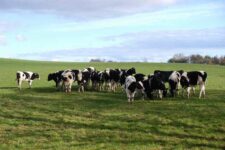Kansas State weed scientist suggests steps to keep weeds from cropping up
MANHATTAN, Kan. — The sights and sounds signs of spring are all around — warm temperatures, chirping birds, blooming tulips, sprigs of green grass popping up and, for some, the unwelcome view of weeds.
Weed management strategies for cattle grazing pastures was a recent topic on the Kansas State University Beef Cattle Institute Cattle Chat podcast. Joining the team of beef experts was K-State extension weed scientist and assistant professor Sarah Lancaster, BCI cattle nutritionist Phillip Lancaster and veterinarian and BCI director Brad White.
White asked the panel: “What should cattle producers think about when planning a weed management strategy?”
“Producers need to know what their goal is,” Sarah Lancaster said. “If the goal is to grow high quality hay, then that weed management strategy is different than one that I would give if the plan is to graze cows on it.”
She said that by focusing on sources of revenue, producers can develop a plan that makes the most economical sense for them.
Sarah Lancaster added the most important piece of advice she gives regarding weed control is to not overgraze the pastures.
“Avoid overgrazing because it is important to keep the forages healthy, and if the grass is stressed, the weeds will establish in the weak spots in the pasture,” she said.
When the green grass first starts sprouting, Phillip Lancaster said some producers are often tempted to turn out the cattle for grazing. His advice: “Don’t do it.”
“With a perennial grass that grows from the roots, it is using its winter storage to grow those first leaves, and if cows are turned out too soon and those first leaves are grazed off it will actually hurt the overall grazing forage production for the spring,” he said.
Depending on the grass type, Phillip Lancaster recommended the stubble height on planted grasses to be 5-6 inches tall before grazing, and 8-10 inches tall for native grasses.
Along with avoiding overgrazing, Sarah Lancaster recommended producers take soil samples from their pastures every 3-4 years and have them tested in a lab.
“Producers should work with their lab to see the preferred sample depth. But as to how many samples to provide, I recommend sampling at least 15 locations in the field for a good representation of the pasture,” she said.
The sample results will show the amounts of pH, nitrogen and phosphorus is in the soil.
“Soil changes slowly over time so this imbalance can be missed,” Sarah Lancaster said. Knowing the soil makeup helps producers and their agronomy consultants create a strategy for timely fertilizer applications.
She added that not all weeds are bad for producers. “Some weeds, like ragweed, have good nutritional value and can be grazed by cattle.”
“With annual weeds if you deplete the seed bank, existing plants are easier to take care of than perennial weeds in which you have to kill the root.”
White added: “The bottom line is that producers need to know what type of weed they are battling, evaluate the soil periodically and have a plan for grazing that takes advantage of the grass attributes without overgrazing.”
To hear more on this topic, listen in to the BCI Cattle Chat podcast online.
FOR PRINT PUBLICATIONS: Links used in this story
BCI Cattle Chat podcast, https://ksubci.org/2021/04/02/war-against-weeds-weed-management-grazing-management-natives-vs-introduced/
K State Research and Extension is a short name for the Kansas State University Agricultural Experiment Station and Cooperative Extension Service, a program designed to generate and distribute useful knowledge for the well being of Kansans. Supported by county, state, federal and private funds, the program has county extension offices, experiment fields, area extension offices and regional research centers statewide. Its headquarters is on the K State campus in Manhattan. For more information, visit www.ksre.ksu.edu. K-State Research and Extension is an equal opportunity provider and employer.
Story by:
Lisa Moser
785-532-2010
lmoser@ksu.edu
More information:
Sarah Lancaster
785-532-7240
slancaster@ksu.edu
Phillip Lancaster
785-532-6323
palancaster@vet.k-state.edu
Brad White
785-532-4243
bwhite@vet.k-state.edu





